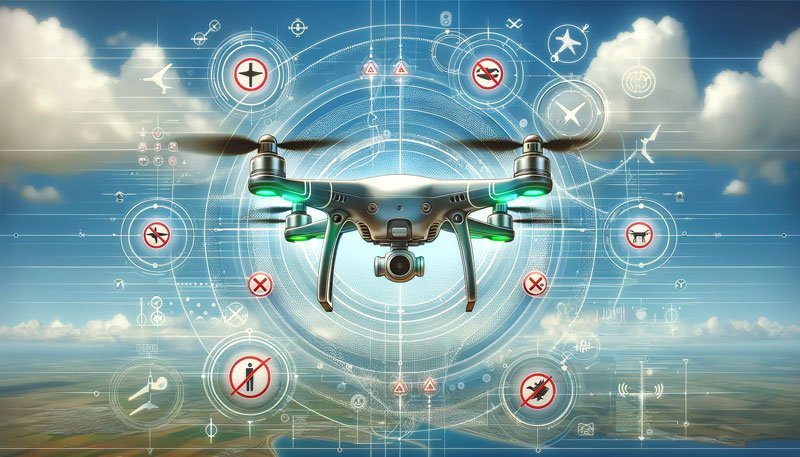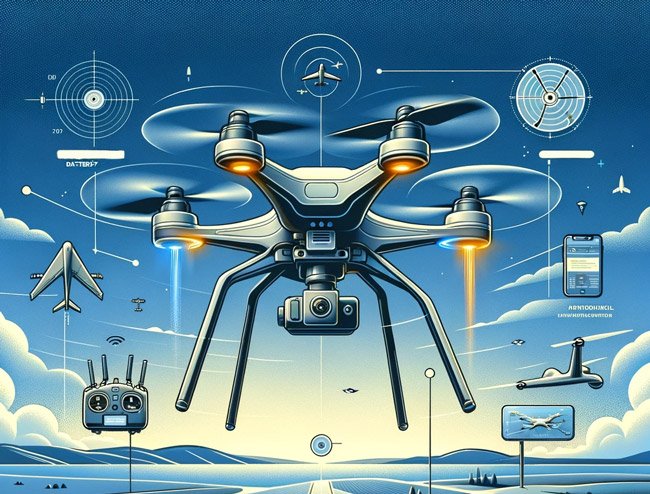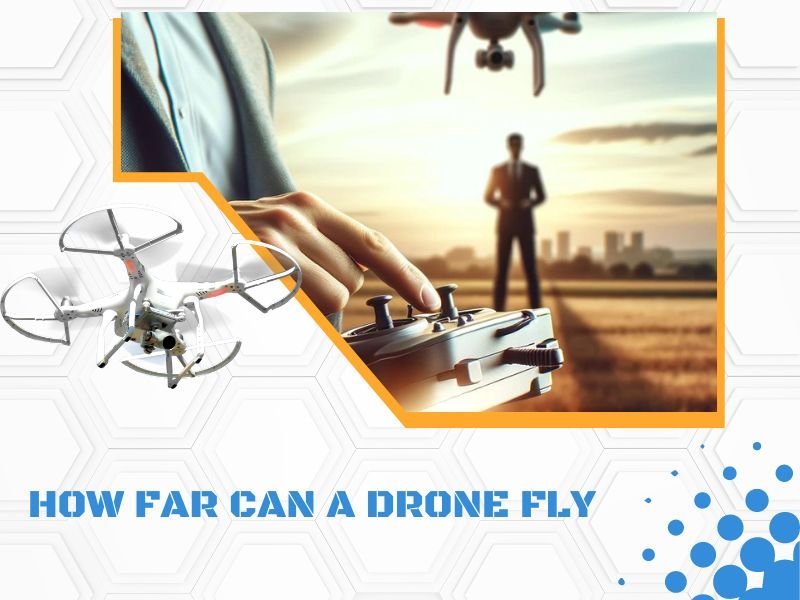Drones have become an increasingly prevalent sight in our skies, capturing breathtaking aerial footage, delivering packages to our doorsteps, and even aiding in search and rescue missions.
But as we witness these airborne marvels buzzing above us, a question arises: just how far can a drone fly?
From the humble toy drone to sophisticated professional models, this informative article aims to unravel the mysteries behind the different factors that determine a drone’s flight range.
So, fasten your seatbelts as we embark on a journey exploring the fascinating world of drone capabilities and the distances they can travel.
Table of Contents
- Understanding the Range Limitations of Drones: Factors that Influence Flight Distance
- The Power and Battery Life: How Long Can Drones Stay Airborne?
- Pushing the Limits: Advanced Technologies and Techniques for Extending Drone Range
- Flight Restrictions and Legal Considerations: Navigating the Boundaries of Drone Flying
- Beyond Visual Line of Sight: The Future of Drone Flight and Regulatory Challenges
- Enhancing Drone Range: Tips and Tricks for Maximizing Flight Distance and Efficiency
- FAQs About How Far Can a Drone Fly
- Conclusion
Understanding the Range Limitations of Drones: Factors that Influence Flight Distance
To fully comprehend the flight capabilities of drones, it is crucial to understand the various factors that can influence their range limitations.
Multiple elements come into play when considering the distance a drone can cover, and these factors can range from the drone’s design and weight to external conditions and technological restrictions.
1. Drone Design and Weight
The design and weight of a drone play a significant role in its flight distance. Heavier drones require more power to stay airborne, which can inherently limit their range.
A drone’s aerodynamics and overall size also affect its ability to achieve greater distances, as streamlined designs tend to be more efficient in terms of thrust and battery consumption.
2. Battery Life
The power source of a drone directly impacts its flight distance. Drones are typically equipped with rechargeable lithium-ion batteries that provide a certain duration of flight time before needing to be recharged.
The battery life varies depending on the drone model and battery capacity, with more advanced models potentially offering longer flight times.
However, it is important to note that battery drain occurs not only during flight but also during other functionalities such as capturing footage or stabilizing the drone’s position.
3. Environmental Conditions
External factors such as weather conditions, temperature, and wind speed can have a significant impact on drone flight distance.
Wind resistance can hinder a drone’s ability to propel forward efficiently, reducing its range.
Additionally, colder temperatures can affect battery performance, potentially shortening the flight duration.
Drone operators need to consider these environmental conditions before attempting long-distance flights.
4. Signal Strength and Interference
The range of a drone can also be influenced by the signal strength and interference from other wireless devices.
Certain drones are equipped with long-range remote controllers or utilize advanced technologies like frequency hopping spread spectrum (FHSS) to minimize signal interference.
However, dense urban areas or locations with high electromagnetic interference can still affect the range and stability of the drone’s control signal.
By understanding these various factors, operators can make informed decisions regarding flight distances and optimize their drone’s performance.
It is important to note that different drone models have different capabilities, and it is advisable to consult the manufacturer’s specifications and guidelines for accurate information on flight limitations.
In the next sections, we will delve deeper into the specifics of battery life, advanced technologies for extending drone range, legal considerations, and real-life examples of long-distance drone flights.

The Power and Battery Life: How Long Can Drones Stay Airborne?
In this section, we will delve into the crucial role of power and battery life in determining how long drones can stay airborne.
The endurance of a drone largely depends on its battery capacity and efficiency, making it essential for drone enthusiasts and operators to understand these factors.
Battery Capacity
The battery capacity, usually measured in milliampere-hours (mAh), determines the amount of energy a drone’s battery can store.
Higher battery capacity generally translates to longer flight times.
It is important to note that the battery capacity varies among different drone models, so it’s advisable to check the specifications provided by the manufacturer.
Battery Efficiency
Apart from the capacity, battery efficiency plays a vital role in determining the flight duration.
Some drones are equipped with more efficient batteries that provide better power output and longer flight times.
Furthermore, advancements in battery technology, such as lithium-polymer (LiPo) batteries, have significantly improved the overall flight performance and endurance of drones.
It is worth noting that several other factors also influence the drone’s power consumption and ultimately affect the flight duration.
These factors include the drone’s weight, altitude, payload, weather conditions, and flight speed.
Understanding these variables is essential for optimizing the battery life and maximizing the time drones can stay airborne.
By carefully considering these factors and employing efficient battery management techniques, such as avoiding aggressive maneuvers and maintaining a steady flight, drone operators can extend their flight times and make the most out of each battery charge.
Overall, the power and battery life are critical aspects to consider when operating a drone.
By understanding the importance of battery capacity and efficiency, and taking into account other influential factors, drone enthusiasts can make informed decisions and plan their flights accordingly to achieve longer, uninterrupted flights.

Pushing the Limits: Advanced Technologies and Techniques for Extending Drone Range
In this section, we will delve into the various technologies and techniques that can be employed to extend the range of drones, allowing them to fly even further distances.
By implementing these advances, drone enthusiasts and professionals alike can maximize the capabilities of their devices and explore new possibilities in aerial exploration and data collection.
Improved Communication Systems
One of the key factors in extending the range of drones is the communication system between the drone and the operator.
Advanced technologies such as long-range transmitters and receivers, as well as robust signal amplifiers and antennas, can greatly enhance the drone’s ability to maintain a steady connection over longer distances.
By increasing the strength and stability of the signal, drone operators can safely control their devices even when they are several kilometers away, pushing the boundaries of flight range.
Lightweight and High-Capacity Batteries
Battery life is one of the primary factors limiting the flight range of drones.
However, advancements in battery technology have allowed for the development of lightweight yet high-capacity drone batteries.
These batteries can provide longer flight times, enabling drones to cover greater distances.
Additionally, techniques such as smart power management systems and efficient power utilization can further maximize battery life, allowing drones to stay airborne for extended periods.
Aerodynamic Design and Propulsion Systems
The design and propulsion systems of drones can also significantly impact their range capabilities.
Manufacturers are continuously working on aerodynamic designs that minimize air resistance and optimize flight efficiency.
Conversely, the propulsion systems, including motors and propellers, are engineered to deliver sufficient thrust while consuming minimal power.
Combined, these advancements contribute to increased flight distances by reducing energy consumption and allowing the drone to operate more efficiently.
By leveraging these advanced technologies and techniques, drone operators can push the limits of flight range, opening up new possibilities for aerial exploration and data collection.
However, it is important to note that implementing these advancements should be done in compliance with local regulations and aviation authorities’ guidelines to ensure safe and responsible drone operations.

Flight restrictions and legal considerations play a crucial role in determining the boundaries of drone flying.
With the increasing popularity of drones, there has been a surge in regulations to ensure the safety, privacy, and responsible use of this technology.
Understanding these rules is essential for drone operators to avoid penalties and potential accidents.
1. Local Laws and Regulations
Each country, and sometimes even specific regions within a country, has its own set of rules and regulations regarding drone flying.
It is important for drone enthusiasts to thoroughly research and familiarize themselves with the local laws before taking their drone for a flight.
Some common regulations may include restrictions on flying near airports, government buildings, or public events.
Additionally, there may be restrictions on flying above a certain altitude or within a certain distance from people or property.
2. Drone Registration and Operator Certification
In many countries, the registration of drones and operator certification is mandatory.
This ensures that drone users are accountable for their actions and helps authorities track the operation of drones more effectively.
Drone pilots may need to complete a training course, pass a written test, or obtain a license or permit before operating a drone legally.
Failure to comply with these requirements may result in fines or even confiscation of the drone.
3. No-Fly Zones
Several areas are designated as no-fly zones due to safety or security concerns.
These include airports, military bases, and national parks.
Drone operators need to be aware of these restricted areas and avoid flying in them.
Some drone manufacturers even build geofencing technology into their drones, preventing them from flying into restricted areas.
Drone enthusiasts must stay updated with the latest regulations as they are subject to change.
Navigating the boundaries of drone flying responsibly ensures not only compliance with the law but also the overall safety of the public and the privacy of individuals.
By following the rules and regulations, drone operators can continue to enjoy their hobby or profession while respecting the rights and safety of others.

Beyond Visual Line of Sight: The Future of Drone Flight and Regulatory Challenges
In recent years, the capabilities of drones have significantly expanded, allowing them to travel longer distances and accomplish more complex tasks.
One area that holds great potential for the future of drone flight is beyond visual line of sight (BVLOS) operations.
Essentially, this refers to the ability of drones to fly beyond the visual range of the operator, relying on other means of navigation and communication.
The concept of BVLOS operations opens up numerous possibilities for industries such as delivery services, search and rescue missions, infrastructure inspections, and even aerial cinematography.
Drones could cover vast distances, reaching remote or hazardous locations that would otherwise be challenging for humans to access.
Additionally, BVLOS operations have the potential to greatly increase the efficiency and productivity of various industries.
However, there are significant regulatory challenges to overcome before BVLOS operations become a widespread reality.
Currently, most countries have strict regulations in place that require drones to remain within the visual line of sight of the operator.
This is primarily to ensure the safety of manned aircraft and other objects in the airspace.
Allowing drones to fly beyond the visual line of sight raises concerns regarding collision avoidance, lost control, and potential unauthorized operations.

Enhancing Drone Range: Tips and Tricks for Maximizing Flight Distance and Efficiency
To get the most out of their drones, drone operators are constantly seeking ways to enhance the range and efficiency of their flights.
Whether it is for professional aerial photography, surveying vast areas, or simply exploring new and remote locations, having a drone with extended range capabilities can greatly expand the possibilities.
Here are a few tips and tricks to maximize flight distance and efficiency:
1. Choose the Right Drone
When it comes to enhancing flight range, selecting the right drone is crucial.
Look for drones that are designed for long-range flights and have good battery life.
Consider drones with more powerful motors, as they can propel the drone further and faster.
2. Optimize Battery Performance
Battery life is a significant factor in determining the range of a drone.
To maximize flight distance, ensure the batteries are properly charged before each flight. It is advisable to invest in spare batteries or battery packs to extend the flight time.
Additionally, keep the batteries in a cool environment, as extreme temperatures can affect their performance.
3. Minimize Weight
Every gram of additional weight can impact the flight range of a drone.
To maximize efficiency, remove any unnecessary accessories or equipment that may add extra weight.
Opt for lightweight propellers and consider using smaller cameras or payload options to reduce the overall weight of the drone.
4. Optimal Flight Planning
Proper flight planning can help in maximizing flight distance.
Plan routes that take advantage of wind direction and speed to increase the speed of the drone and conserve energy.
Additionally, plan flights in areas with minimal interference and obstacles to avoid unnecessary course corrections and excessive power consumption.
5. Utilize Antenna Enhancements
Upgrading the antennas on the drone and the remote controller can significantly enhance the range.
Consider using high-gain antennas or antenna extenders to boost the signal strength and extend the operating range.
By implementing these tips and tricks, drone operators can greatly enhance their drone’s range and flight efficiency.
However, it is important to keep in mind that safety guidelines and regulations should always be followed.
Fly responsibly and within legal limits to ensure a successful and enjoyable drone flight experience.

FAQs About How Far Can a Drone Fly
1. What is the maximum range of a consumer drone?
Consumer drones typically have a maximum range between 1-7 kilometers (0.6-4.3 miles) depending on the specific model and its technology.
Factors such as battery life, signal strength, and drone regulations may also affect the range.
2. Can drones fly long distances?
Yes, certain drones designed for long-range flights can fly distances of up to 20 kilometers (12.4 miles) or even more.
These drones often have advanced features like extended battery life, powerful signal transmission, and GPS navigation systems.
3. How far can a professional drone fly?
Professional drones used for various applications, such as aerial photography or surveying, can fly up to 10 kilometers (6.2 miles) or more.
These drones are typically equipped with high-quality components and advanced technology to ensure reliable long-distance flights.
4. What affects the range of a drone?
Several factors can impact the range of a drone.
These include the drone’s battery capacity and efficiency, signal strength and interference, weather conditions, and local regulations.
It is important to consider these factors when planning long-distance drone flights.
5. Can a drone fly across the country?
Flying a drone across an entire country is generally not practical or legal due to various restrictions and regulations.
Most countries have specific airspace regulations and flight restrictions that limit the range and flight paths of drones.
Conclusion
In conclusion, the maximum range of a drone can vary depending on factors such as the type of drone, its technology capabilities, and regional drone regulations.
Consumer drones typically have a maximum range of 1-7 kilometers, while drones designed for professional use can fly up to 10 kilometers or more.
However, it is important to consider other factors like battery life, signal strength, and local regulations when planning long-distance drone flights.


